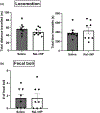Slow-sustained delivery of naloxone reduces typical naloxone-induced precipitated opioid withdrawal effects in male morphine-dependent mice
- PMID: 32772457
- PMCID: PMC9809991
- DOI: 10.1002/jnr.24627
Slow-sustained delivery of naloxone reduces typical naloxone-induced precipitated opioid withdrawal effects in male morphine-dependent mice
Abstract
Thousands of individuals die each year from opioid-related overdoses. While naloxone (Narcan®) is currently the most widely employed treatment to reverse opioid toxicity, high or repeated doses of this antidote often lead to precipitated opioid withdrawal (POW). We hypothesized that a slow linear release of naloxone from a nanoparticle would induce fewer POW symptoms compared to high-dose free naloxone. First, we measured the acute impact of covalent naloxone nanoparticles (Nal-cNPs) on morphine-induced antinociception in the hotplate test. We found that Nal-cNP treatment blocked the antinociceptive effect of morphine within 15 min of administration. Next, we tested the impact of Nal-cNPs on POW symptoms in male morphine-dependent mice. To induce morphine dependence, mice were treated with 5 mg/kg morphine (or saline) twice-daily for six consecutive days. On day 7 mice received 5 mg/kg morphine (or saline) injections 2 hr prior to receiving treatment of either unmodified free naloxone, a high or low dose of Nal-cNP, empty nanoparticle (cNP-empty), or saline. Behavior was analyzed for 0-6 hr followed by 24 and 48 hr time points after treatment. As expected, free naloxone induced a significant increase in POW behavior in morphine-dependent mice compared to saline-treated mice upon free naloxone administration. In comparison, reduced POW behavior was observed with both doses of Nal-cNP. Side effects of Nal-cNP on locomotion and fecal boli production were measured and no significant side-effects were observed. Overall, our data show that sustained release of naloxone from a covalent nanoparticle does not induce severe POW symptoms in morphine-dependent mice.
Keywords: drug delivery system; morphine; naloxone; nanoparticle; withdrawal.
© 2020 Wiley Periodicals, Inc.
Conflict of interest statement
CONFLICT OF INTEREST
There are no conflict of interest to declare.
Figures







Similar articles
-
Brain reward deficits accompany naloxone-precipitated withdrawal from acute opioid dependence.Pharmacol Biochem Behav. 2004 Sep;79(1):101-8. doi: 10.1016/j.pbb.2004.06.006. Pharmacol Biochem Behav. 2004. PMID: 15388289
-
Fecal microbiota transplantation and antibiotic treatment attenuate naloxone-precipitated opioid withdrawal in morphine-dependent mice.Exp Neurol. 2021 Sep;343:113787. doi: 10.1016/j.expneurol.2021.113787. Epub 2021 Jun 18. Exp Neurol. 2021. PMID: 34153321 Free PMC article.
-
Repeated experience with naloxone facilitates acute morphine withdrawal: potential role for conditioning processes in acute opioid dependence.Pharmacol Biochem Behav. 2003 Dec;76(3-4):493-503. doi: 10.1016/j.pbb.2003.09.006. Pharmacol Biochem Behav. 2003. PMID: 14643849
-
Conditioning processes contribute to severity of naloxone-precipitated withdrawal from acute opioid dependence.Psychopharmacology (Berl). 2004 Oct;175(4):463-72. doi: 10.1007/s00213-004-1843-5. Psychopharmacology (Berl). 2004. PMID: 15083263
-
In vivo and in vitro attenuation of naloxone-precipitated experimental opioid withdrawal syndrome by insulin and selective KATP channel modulator.Psychopharmacology (Berl). 2015 Jan;232(2):465-75. doi: 10.1007/s00213-014-3680-5. Epub 2014 Jul 26. Psychopharmacology (Berl). 2015. PMID: 25059539
Cited by
-
Recent advances in nanotherapeutics for HIV-associated neurocognitive disorders and substance use disorders.Nanomedicine (Lond). 2025 Mar;20(6):603-619. doi: 10.1080/17435889.2025.2461984. Epub 2025 Feb 18. Nanomedicine (Lond). 2025. PMID: 39963928 Free PMC article. Review.
-
Nanotherapeutics for Alleviating Anesthesia-Associated Complications.Adv Sci (Weinh). 2024 Apr;11(15):e2308241. doi: 10.1002/advs.202308241. Epub 2024 Feb 11. Adv Sci (Weinh). 2024. PMID: 38342603 Free PMC article. Review.
-
Countermeasures for Preventing and Treating Opioid Overdose.Clin Pharmacol Ther. 2021 Mar;109(3):578-590. doi: 10.1002/cpt.2098. Epub 2020 Nov 29. Clin Pharmacol Ther. 2021. PMID: 33113208 Free PMC article. Review.
-
Isolation and Bioassay of Linear Veraguamides from a Marine Cyanobacterium (Okeania sp.).bioRxiv [Preprint]. 2025 Jan 22:2025.01.18.633713. doi: 10.1101/2025.01.18.633713. bioRxiv. 2025. Update in: Molecules. 2025 Feb 04;30(3):680. doi: 10.3390/molecules30030680. PMID: 39896503 Free PMC article. Updated. Preprint.
-
Opioid replacement therapy with methadone or buprenorphine effects on male mice reproduction.Psychopharmacology (Berl). 2023 Jan;240(1):77-86. doi: 10.1007/s00213-022-06274-7. Epub 2022 Nov 17. Psychopharmacology (Berl). 2023. PMID: 36385208 Free PMC article.
References
-
- (SAMHSA), S. A. a. M. H. S. A. (2003). Overview of findings from the 2002 National Survey on Drug Use and Health Rockville, MD: S. A. a. M. H. S. Administration. Office of Applied Studies.
-
- Anand K, Tiloke C, Naidoo P, & Chuturgoon AA (2017). Phytonanotherapy for management of diabetes using green synthesis nanoparticles. Journal of Photochemistry and Photobiology B: Biology, 173, 626–639. - PubMed
-
- Bailey K, & Crawley JN (2009). Anxiety-related behaviors in mice. In Buccafusco J (Ed.), Methods of behavior analysis in neuroscience (pp. 79–82). Boca Raton, FL: CRC Press/Taylor & Francis. - PubMed
-
- Bhalla S, Pais G, Tapia M, & Gulati A (2015). Endothelin ETA receptor antagonist reverses naloxone-precipitated opioid withdrawal in mice. Canadian Journal of Physiology and Pharmacology, 93(11), 935–944. - PubMed
MeSH terms
Substances
Grants and funding
LinkOut - more resources
Full Text Sources
Research Materials

